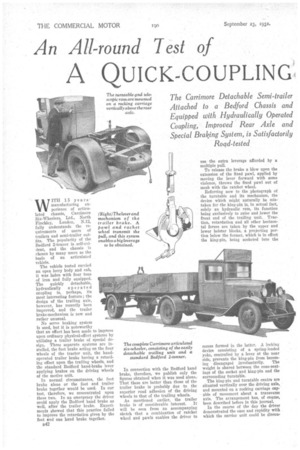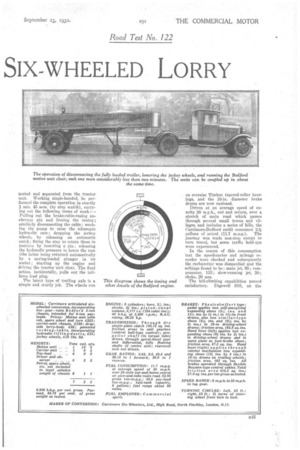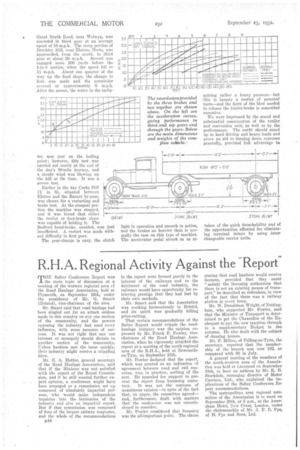An All-round Test of
Page 60

Page 61

Page 62

If you've noticed an error in this article please click here to report it so we can fix it.
A QUICK-COUPLING
SIX-WHEELED LORRY
The Carrirnore Detachable Semi-trailer Attached to a Bedford Chassis and Equipped with Hydraulically Operated Coupling, Improved Rear Axle and Special Braking System, is Satisfactorily Road-tested
WITH 15 years' manufacturing experience of articulated chassis, Carrimore Six-Wheelers, Ltd., North Firtchley, Loudon, N.12, fully understands the requirements of users of trailers and semi-trailer outfits. The popularity of the Bedford 2-tonner is self-evident, and the chassis is chosen by many users as the basis of an articulated vehicle.
The vehicle tested carded an open lorry body and cab, it was laden with four tons of iron and fully equipped. The quickly detachable, hydraulically operated coupling is, perhaps, its most interesting feature ; the design of the trailing axle, however, has recently been improved, and the trailer brake-mechanism is new and rather unusual.
No servo braking system is used, but it is noteworthy that an effort has been made to improve upon ordinary physical-effort systems by utilizing a trailer brake of special design. Three separate systems are installed, the foot brake acting On the four wheels of the tractor unit, the handoperated trailer brake having a retarding effect upon the trailing wheels, and the standard Bedford hand-brake lever applying brakes on the driving wheels of the motive unit.
In normal circumstances, the foot brake alone or the foot and trailer brake together would be used. In our test, therefore, we concentrated upon these two. In an emergency the driver could apply the Bedford hand brake as well, after the trailer brake. Experiments showed that this practice failed to improve the retardation given by the foot and one hand brake together. In connection with the Bedford band brake, therefore, we publish only the figures obtained when it was used alone. That these are better than those of the trailer brake is probably due to the superior road adhesion of the driving wheels to that of the trailing wheels.
As mentioned earlier, the trailer brake is of considerable interest. It will be seen from an accompanying sketch that a combination of ratchet wheel and pawls enables the driver to use the extra leverage afforded by a multiple pull.
To release the brake a blow upon the extension of the fixed pawl, applied by moving the lever forward with some violence, throws the fixed pawl out of mesh with the ratchet wheel.
Referring now to the photograph of the turntable and its mechanism, the device which might naturally be mistaken for the king-pin is, in actual fact, solely an hydraulic ram, its function being exclusively to raise and lower the front end of the trailing unit. Traction, retardation and all other horizontal forces are taken by the upper and lower bolster blocks, a projecting portion below the former, which is in effect the king-pin, being socketed into the
recess formed in the latter. A locking device consisting of a spring-loaded yoke, controlled by a lever at the near side, prevents the king-pin from becoming disengaged involuntarily. The weight is shared between the cone-seatjugs of the socket and king-pin and the surrounding turntable.
The king-pin and turntable centre are situated vertically over the driving axle, and mounted on a rocking carriage capable of movement about a transverse axis. The arrangement has, of course, been described before in this journal.
In the course of the day the driver demonstrated the ease and rapidity with which the carrier unit could be discon
'meted and separated from the tractor unit. Working single-handed, he performed the complete operation in exactly 1 min. 45 sees. (by stop watch), carrying out the following items of work ;— Pulling out the brake-cable-casing anchorage pin and freeing the easing; similarly disconnecting the cable ; working the pump to raise the telescopic hydraulic ram ; dropping the jockey wheels, by releasing an automatic catch ; fixing the stay to retain these in position by inserting a pin ; releasing the hydraulic pressure to lower the ram (the latter being returned automatically by a spring-loaded plunger in its socket ; starting up the engine and driving the tractor nit'clear. The final action. incidentally, pulls out the taillamp lead plug.
The latest type of trailing axle is a simple and sturdy job. The wheels run on oversize Timken tapered-roller bearings, and the 16-in, diameter brake drums are now enclosed.
Drive-n at an average speed of exactly 20 m.p.h., out and return, over a stretch of main road which passes through several small towns and villages, and includes a series of hills, the Carrimore-Dedford outfit consumed 2126 gallons of petrol (11.7 m.p.g.). The journey was made non-stop except to turn round, but some traffic hold-ups were experienced.
In the course of this consumption test the speedometer and mileage recorder were checked and subsequently the carburetter was dismantled and the settings found to be: main jet, 65; cornpcnsator, 115; slow-running jet, 50; choke, 20 mm.
The hill-climbing capabilities proved satisfactory. Digswell Hill, on the Great North Road, near Welwyn, was ascended in third gear at an average speed of 16 m.p.h. The steep portion of Brockley Hill, near Elstree. Harts, was approached, from the south, in third gear at about 20 m.p.h. Second was engaged some 200 yards before the 1-in-8 section, when the speed fell to
11 m.p.h. About one quarter of the way up the final slope, the change to first was made and the remainder covered at approximately 6 m.p.h. After the ascent, the water in the radia
tor was just on the boiling point ; however, this test was carried out nearly at the end of the day's 80-mile journey, and a steady wind was blowing up the hill at the time. It was a severe test.
Earlier in the day Cocks Hill (1 in 6), situated between Elstree and the Barnet by-pass, was chosen for a restarting and brake test. At the steepest portion the machine was stopped, and it was found that either the trailer or foot-brake alone was capable of holding it. The Bedford hand-brake, unaided, was just insufficient. A restart was made without difficulty in first gear.
The gear-change is easy, the clutch 11 • • I OxZ
The retardation provided by the three brakes and two together are shown above. On the left are the acceleration curves, giving performance in third and top gears and through the gears. Below are the main dimensions and weights of the com
plete vehicle.
light in operation and smooth in action, and the brakes no heavier than is normally the case on this type of machine. The accelerator pedal struck us as re
graving rather a heavy pressure—but this is largely a matter of personal taste—and the force of the blow needed to release the trailer-brake is somewhat excessive.
We were impressed by the sound and substantial construction of the trailer and conversion unit, as well as by the performance. The outfit should stand up to hard driving and heavy loads and prove an aid to keeping down expenses generally, provided full advantage be
taken of the quick detachability and of the opportunities afforded for eliminating terminal delays by using interchangeable carrier units.






































































































